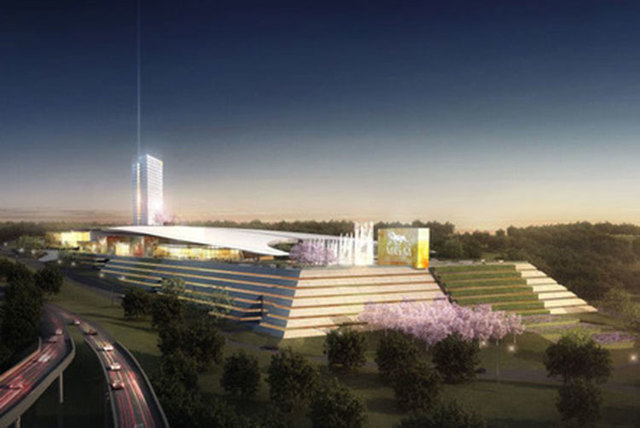Despite high taxes, MGM National Harbor offers huge potential

MGM Resorts International had a busy March.
And that’s without the unsolicited offer from a minor shareholder to convert the casino giant into a real estate investment trust.
On March 24, MGM officials broke ground on the Las Vegas-based company’s $800 million hotel-casino development in Springfield, Mass.
A day later, MGM leadership celebrated the hiring of the 1,000th construction worker for the $1.25 billion MGM National Harbor in Maryland.
The National Harbor ceremony couldn’t really be described as a groundbreaking. The quarter-mile-long, 23-acre site along Interstate 95 outside Washington has already seen the excavation of 500,000 cubic yards of soil — enough dirt to fill M&T Bank Stadium in nearby Baltimore, home of the National Football League’s Baltimore Ravens.
The two developments — Maryland opens in late 2016 and Massachusetts follows a year later — will give MGM Resorts solid footing in the nation’s regional gaming market. The company already operates casinos in Detroit and Mississippi.
“We think both of these projects can be successful because they will be superior products in good locations,” Janney Montgomery Scott gaming analyst Brian McGill told investors.
MGM’s 250-hotel room, 125,000-square-foot casino development in Springfield — the state’s first full-scale gaming complex — is the centerpiece of a downtown redevelopment for the western Massachusetts city. The site has struggled to recover since a tornado tore through the area in 2011.
MGM National Harbor offers a much different perspective.
The project is attached to the 150-acre National Harbor development, a mixed-used retail, dining, residential and hotel complex built by the Peterson Cos. of Fairfax, Va. The site once housed a rock and gravel quarry along the Potomac River.
Today, more than 5,000 people work in National Harbor and the location draws 8 million to 10 million annual visitors. The 2,000-room Gaylord National has nearly 500,000 square feet of meeting space. The development has a water taxi service that ferries visitors to and from the National Mall in Washington; historic Alexandria, Va.; Georgetown; and Washington Nationals baseball games.
Adding a facility like MGM National Harbor was the reason developers fought long and hard to win Maryland’s sixth — and last — gaming license.
Stifel Nicolaus Capital Markets gaming analyst Steve Wieczynski said the resort has the potential to be one of the top-producing regional gaming facilities in the United States. He predicted MGM National Harbor will produce annual cash flow of $175 million to $250 million.
Wieczynski could be described as a fan for the development, but rightfully so. His office in Baltimore is less than an hour’s drive from the site. The proximity offers Wieczynski a healthy understanding of the highly competitive market that surrounds the Washington Beltway.
“We like the fact National Harbor sits within 10 miles of downtown D.C. and will be the closest gaming asset to that market,” Wieczynski told investors last month after touring the MGM site.
The region’s gaming environment is competitive. The northern Virginia area is filled with potentially lucrative gaming customers. Those players travel to Atlantic City, or head to casinos in West Virginia (Penn National Gaming’s Charlestown Races), or Baltimore (Cordish Cos.’ Maryland Live! and Caesars Entertainment Corp.’s Horseshoe Casino Baltimore).
“Given MGM’s track record of catering to high-end players and having upscale assets in Las Vegas and Macau, we believe MGM will have the upper hand of attracting some of these players to the new facility,” Wieczynski said.
Susquehanna International Group gaming analyst Rachael Rothman agreed that MGM National Harbor, which will have a 4,800-space parking garage and a restaurant lineup that matches the company’s Strip casinos, will be a preferred destination for the affluent population bases in Virginia and Maryland.
The development has 3.8 million people living within a 25-mile radius. Another 7.1 million people live within 50 miles of the site.
Wieczynski expects MGM to cross-market National Harbor with the company’s Strip resorts, such as Bellagio, MGM Grand, Mandalay Bay and Aria.
Even with the $1.2 billion price and Maryland’s excessive gaming tax rate — 61 percent on slot machine revenue and 21 percent on table game winnings — the analyst believes the property will generate at least a 20 percent return on investment.
“We typically aren’t proponents of regional assets, which call for significant capital commitments given the lackluster returns and potential cannibalization most of these properties can witness,” Wieczynski said. “However, we believe MGM’s National Harbor property will be able to generate above average returns.”
Meanwhile, MGM Resorts continues to review the REIT proposal suggested by New York hedge fund Land and Buildings Investment Management, which owns less than 1 percent of the company’s stock.
The activist investment group believes MGM Resorts can reduce its debt by $5 billion and increase its valuation by moving its casinos and land holdings into a publicly traded REIT and leasing back its casinos.
Where National Harbor and Springfield fit into this equation is unclear.
Union Gaming Group analyst Chris Jones said the market ignores the earning potential of MGM Resorts’ regional gaming portfolio. The stock prices in other regional companies trade at elevated multiples.
“The investment community today assigns little if any value to MGM’s regional casinos, with some investors still unaware of the strength of MGM’s regional operations,” Jones said.
Howard Stutz’s Inside Gaming column appears Wednesdays and Sundays. He can be reached at hstutz@reviewjournal.com or 702-477-3871. Find on Twitter: @howardstutz.